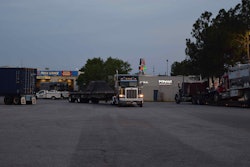 From left: Scott Grenerth, of Truck Specialized Parking Services; Sherry Pifer, of the Texas DOT ; owner-operator Ingrid Brown; and trucker Jack Smith.
From left: Scott Grenerth, of Truck Specialized Parking Services; Sherry Pifer, of the Texas DOT ; owner-operator Ingrid Brown; and trucker Jack Smith.In late August, hooked to a load bound for the Dallas-Fort Worth metro area, Clark Freight Lines driver Jack Smith found a truck stop near his delivery point via a popular mapping/locator app. Even though the app said the truck stop was full — at 2 p.m. in the afternoon — Smith decided to try his luck, anyway. To his frustration, the app was right, and Smith says he was faced with the possibility of having to drive 30-40 miles away from his delivery point to find parking — meaning he’d have to deal with rush hour traffic the next morning to get to the receiver.
“I was able to find a warehousing district,” he says, and he drove around until he came across a handful of spaces at the end of dead-ended lanes where “you’re out of harm’s way and out of traffic.”
The next day, Smith hit the same problem. After making his drop-off and picking up his next load, he was preparing to stop for the night in the Dallas-Fort Worth area. “There was a truck stop on I-20 between I-35E and 45,” he recalled. “About a 150-space truck stop.” But at 2:30 in the afternoon, it too was already full.
“It was shocking,” he says. “It’s usually no problem whatsoever” to find a space “that early in the day.”
He detailed these anecdotes — likely all-too-familiar for most truckers — at the Great American Trucking Show in Dallas last month in a panel discussion that explored the protracted challenges drivers face in finding safe truck parking and potential solutions to tackle the problem.

With a focus on Texas, as part of the state’s ongoing study into how it can address the parking shortage within its borders, Smith joined owner-operator Ingrid Brown, former owner-operator and current parking advocate Scott Grenerth (of Truck Specialized Parking Services) and Sherry Pifer, a freight planning manager for the Texas Department of Transportation.
TxDOT has been gathering parking data and anecdotes since August 2018 as part its work to develop an action plan for the state to add safe parking capacity, with a final report and recommendations slated to be filed next spring.
Pifer is one of the TxDOT officials spearheading that effort. “Drivers are the people who tell the story,” she said, noting the state is pressing drivers for feedback on challenges they face in finding parking and solutions they could offer to remedy those challenges.
As highlighted by Smith’s story, lack of capacity, combined with high demand for parking spaces around major cities and freight hubs, is a common refrain TxDOT has heard during its data gathering phase, she said. Such input is vital to helping the state plot its path forward in developing parking, she said.
For example, building off of the lack of parking in metro areas and around freight hubs, TxDOT plans to recommend construction of pared-down lots with simple amenities that could be used as staging areas for truckers to park and wait for delivery or pick-up times. The state is hoping to build public-private partnerships “near freight zones, so if a shipper tells you ‘I’m not ready yet,’ you don’t have to drive 60 miles to go park,” Pifer said.
Grenerth, who moderated the panel’s discussion, agreed that such an approach could help resolve one piece of the complex parking puzzle. “There’s a need for overnight parking, but [there’s also a need] for a spot where you can pull in, avoid traffic, wait for your delivery and be close to your destination,” he said. Such staging areas “don’t have to be open 24 hours,” Grenerth said. “That might be a way of alleviating local concerns that there are going to be ‘trucks idling all night long’ or whatever,” he said, tossing up air quotes to chide an oft-heard refrain from those speaking against truck parking expansion in their areas.
“People don’t understand. We have nowhere to go,” said owner-operator Brown. “Staging lots — I’m all for that.”
The data collected so far “tells the same story” relayed by Smith and Brown, said Pifer. “Eighteen percent of all locations are at or over capacity at all hours of the day. Sixty percent of large truck stops with 100 spaces or more are at or over capacity at some point during the day.”
The panelists agreed that repurposing large abandoned lots, such as those at big-box retailers or at malls that have been shut down, could also offer an avenue for expanding capacity. “Malls are a thing of yesterday,” said Pifer. “Places like that could be an opportunity” to expand parking, “but it’s going to take coordination between the states and private sector” to revamp them.












